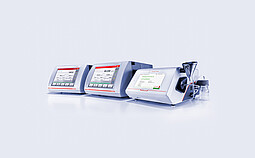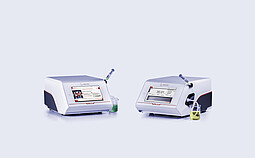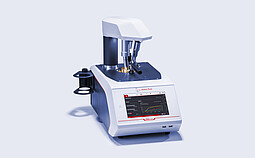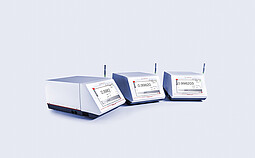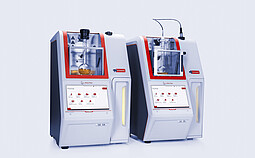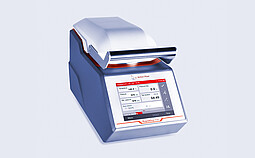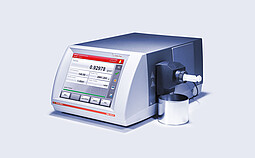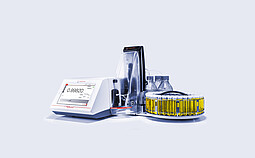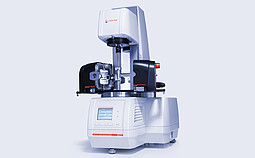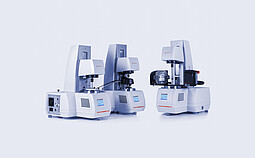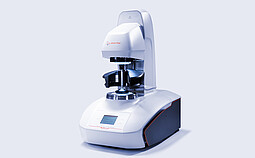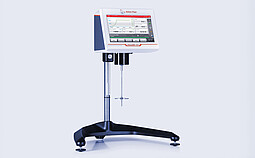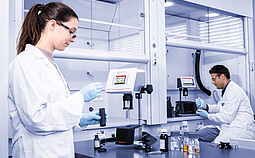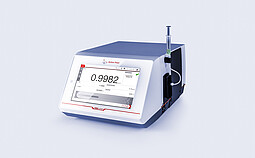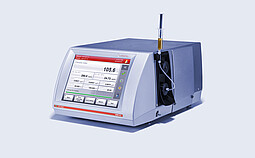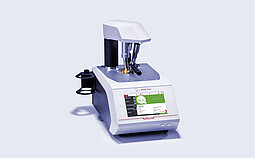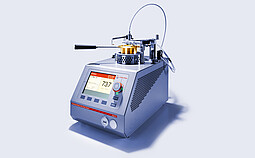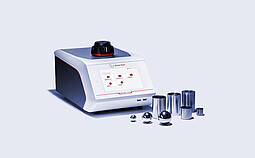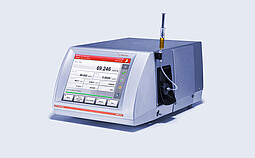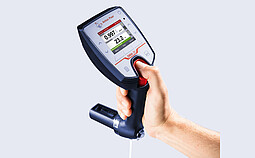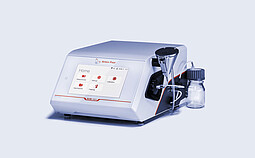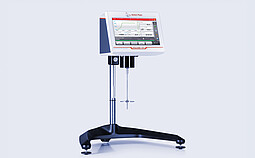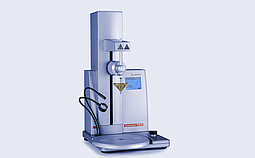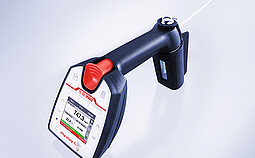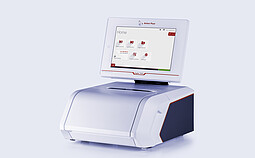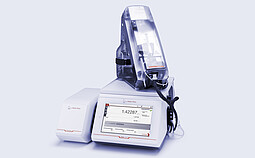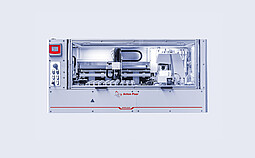Lubricants make our everyday lives run smoothly. From car engines to wind turbines and conveyor belts – all these machines need to be properly lubricated to ensure the highest performance, long component lifespan, and short downtimes. Lubricant testing requires accurate, robust, and flexible measuring solutions, able to cover a large array of samples, from thin oils to high-viscosity greases. Anton Paar provides laboratory and process instrumentation for a wide range of measurements. From characterizing base oils and lubricant blends to performing oil condition monitoring for in-service oils and greases, our instruments give insight into rheological behavior and deliver parameters such as viscosity, density, oxidation stability, flash point, and many more.
Lubricant testing at refineries
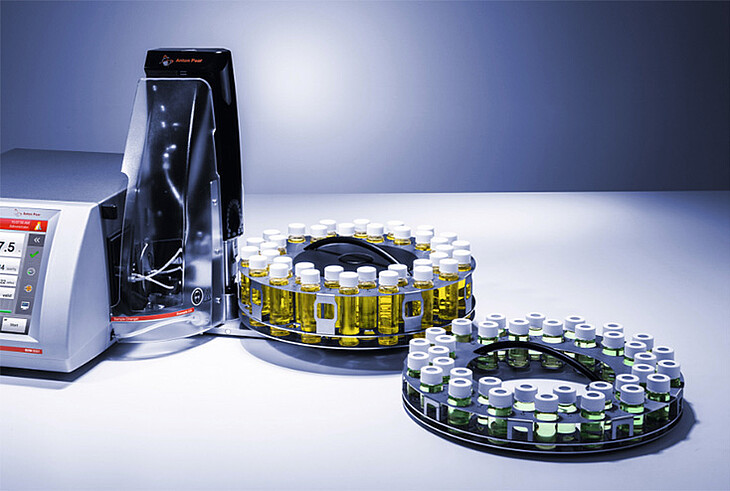
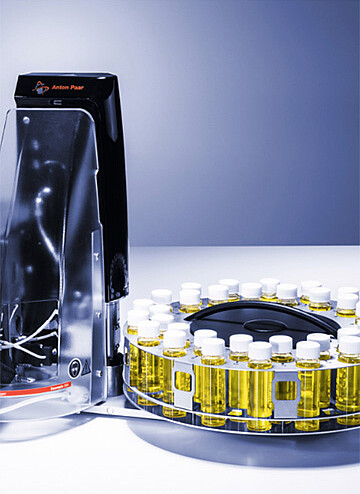
Certifying lubricants and novel formulations according to relevant standards
To ensure that your intermediate and final products fulfill the specifications at defined process steps, Anton Paar devices are available to help you:
- Save time when determining the viscosity and viscosity index of your products. Our SVM viscometer covers the whole viscosity range so you can measure everything from base oils to blends and additives with one instrument and save huge amounts of solvent and sample (only min. 2.5 mL required), all while providing the fastest viscosity index measurement on the market.
- Obtain official certification for all your products via density measurement on small sample volumes of only 1 mL and at the highest accuracy and the appropriate measuring temperature for any type of sample.
- Measure the flash point safely on a device with almost zero maintenance requirements.
- Characterize the oxidation stability with maximum efficiency and analyze the distillation of different ASTM D86 distillation groups.
- Measure the refractive index to meet quality control requirements and get more insight into your samples' properties (e.g. carbon-type composition or carbon distribution).
Relevant products:
Measuring the density and viscosity of highly viscous samples
Filling your density meter or viscometer properly can be challenging when it comes to heavy samples as they require heating. Anton Paar offers heated sample changers which minimize the operator’s contact with hot substances and contribute to your lab’s safety and productivity. Even if tempering is not necessary to be compliant, heating samples makes filling quicker and easier and increases your throughput per day.
- Heated sample changer for single samples
- Headed sample changer with 36-position magazine
Automating measurements and data transfer to increase your productivity
Automating measurements is the quickest way to become more efficient and sustainable in your laboratory. By automating the filling and cleaning steps you remove the risk of handling errors, reduce the required volume of cleaning agent, and greatly improve the repeatability of your analysis. Reusing your consumables greatly benefits the environment and your budget. Anton Paar’s viscometers and density meters, for example, can be automated for continuous measurement of up to 71 samples, including fuel samples that require heating before measurement.
To increase productivity further, Anton Paar’s lab execution software communicates with your LIMS and automates your data flow (collecting, storing, representing, and transferring the measurement results), contributing to the paperless lab.
Relevant products:
Determining the shear viscosity of lubricating greases
During the quality control of greases, the shear stability is one of the key parameters. Anton Paar's rheometers provide a powerful solution for rapid and highly accurate tests according to the relevant standards. The intuitive software with predefined test programs greatly reduces the amount of operator time required and enables convenient data management.
Relevant products:
Optimizing sample preparation (digestion) for elemental analysis (ICP)
Before analysis with ICP units, e.g. to measure the exact concentration of elements like Ni, V, Si, Na, or Al in petroleum samples, a good sample preparation is key but can often keep you waiting. Microwave-assisted digestion considerably reduces the time needed to prepare your petroleum samples for ICP analysis. Anton Paar’s digestion devices provide:
- Huge time-savings compared to conventional preparation methods
- Built-in safety features to protect your staff and facility
- Menu-guided operation so personnel need only basic training
- The option to digest many different samples in one run
Complete digestion of samples is essential when investigating corrosion problems, deactivation of catalysts, or abrasion within the combustion engine and when monitoring elemental impurities.
Characterizing new blends and environmentally acceptable lubricants
Whenever new lubricants need to be characterized, the modular concept of Anton Paar’s portfolio of measuring instruments allows the simultaneous determination of various physical properties at the same time and under the same conditions. Only small sample volumes of a few mL are required to determine parameters such as viscosity and viscosity index, density, flash point, distillation, oxidation stability, and more. Measuring modules can be combined to create a system that is operated via only one user interface and, thanks to state-of-the-art Peltier technology, measurement at different temperatures is highly convenient.
Relevant products:
Determining the cloud and pour point of incoming crude oil
Incoming crude oil needs to flow well at all times, even at low temperatures. Cloud and pour point of crude oil can be assessed using Anton Paar rheometers and viscometers. The results tell about the crude’s flow behavior and how the concentration of pour point depressants affects the flow. Even slight changes in the concentration of these additives have a significant influence on the flow so the analysis from a rheometer can be used to find the ideal concentration of depressants to keep crude oil moving.
Obtaining the correct distillation cuts during crude oil distillation
When separating the crude oil into its constituent parts based on the different temperatures at which they evaporate and condense during refining, 1 °C can make a substantial financial difference. To make sure you take the right distillation cuts from a distillation tower, you need to know the boiling range of the product very well. You can gain this knowledge by simulating the distillation in the lab. Anton Paar’s distillation analyzer:
- Gets you the results fast – so you lose the minimum time finding the optimal cut point temperatures.
- Delivers the exact temperature at a resolution of 0.1 °C
- Provides a volume resolution of only 0.01 mL
- Guarantees maximum safety and optimized output of your crude oil
Low-Temperature viscosity tests according to ASTM D2983, D8210, D5133, D7110, and DIN 51398
For lubricant testing, the ViscoQC 300 rotational viscometer and PTD 175 Peltier temperature device are the perfect setup for low-temperature viscosity tests (ASTM D2893/D8210 and DIN 51398) and measurements using the temperature-scanning technique (ASTM D5133, D7110). The methods are fully automated and generate a final report with all the necessary data. The compact design saves valuable lab space. The highly efficient Peltier temperature device has very low power consumption and is air counter-cooled. Therefore, no high-risk cooling liquids (e.g., methanol) are required, unlike with thermostatic baths.
Relevant products:
How to safeguard standards-compliant certification of final products
Obtain official certification for all your products via density measurement on small sample volumes of only 1 mL and with the highest accuracy and the appropriate measuring temperature for any type of sample. Comply with ASTM D4052, D5002, D1250, ISO 12185 petroleum standards and ensure your results are traceable to the International System of Units (SI) with ISO 17025 calibration from our accredited lab.
Relevant products:
Quality control of base oils after refining
Quality control of the base oil after the refining process can be a time-consuming matter as multiple parameters need to be checked at different temperatures, and with different instruments, to ensure the finished product complies with the relevant standard. SVM 4001 is the optimal solution: The innovative dual cell design allows simultaneous measurements at two different temperatures from only 2.5 mL from just one filling. This allows fast but precise analysis of viscosity, density and the viscosity index with a single instrument, saving time and costs, for a more efficient operation.
Relevant products:
Determining the flash point of flammable liquids according to given product specifications
Quality control of the base oil after the refining process can be a time-consuming matter as multiple parameters need to be checked at different temperatures and with different instruments to ensure the finished product complies with the relevant standard. SVM 4001 is the optimal solution: The innovative dual cell design allows simultaneous measurements at two different temperatures from only 2.5 mL from just one filling. This allows fast but precise analysis of viscosity, density, and the viscosity index with a single instrument, saving time and costs, for a more efficient operation.
Relevant products:
Determination and investigation of the oxidation stability of lubricating greases
Demands related to the oxidation stability of greases are unique: Independent from specific applications, they are exposed to factors promoting oxidation, such as high temperatures and the catalytically active metals they are applied on. To guarantee their purpose, dedicated properties must remain during application, and sufficient oxidation stability for greases is a must and has to be guaranteed from the beginning. This is challenging for both the formulation and the quality testing. High-oxidation stability often comes at a price – long and tedious testing procedures. Luckily, Anton Paar offers a quick and reliable way of lubricant testing. RapidOxy 100, the only RSSOT (Rapid Small-Scale Oxidation Tester) on the market, features a fast, safe, and user-friendly way to determine oxidation stability under accelerated conditions according to ASTM D8206. The high temperature range of RapidOxy 100 up to 180 °C is unique and absolutely crucial to allow for reliable results within comparably very short test times. Even more lab time is saved due to the simple setup, the fully automatic measurement, and close to no cleaning effort. Setting up a measurement and getting the instrument ready again after lubricant testing can be done in less than five minutes. At the moment, the development of a new standard method including catalytically active metal for a method close to application of greases is in progress. Whether it is research and development or quality control, the RapidOxy 100 can handle the challenge.
Relevant products:
Density analysis for petroleum oil and grease
Petroleum manufacturing and grease producers rely heavily on density measurements to assess the quality of the formulation and its performance. Grease’s primary function is to provide a protective coating to prevent friction and wear. In order for a grease formulation to stay in place and not float, thickening agents are added to the formulation. As fluid formulation gets thicker and more viscous, the density increases. The density value also determines the amount of grease that is required for a particular surface. For example, high-density grease like PFPE requires twice the amount for a particular area when compared to a standard hydrocarbon-based grease. There are many methods to determine the density of viscous grease material. One of them is the liquid displacement method that uses a glass cylinder or a glass flask with opposite polarity solvent, typically water. This method, which is time-consuming, involves breakable equipment and relies on extensive clean-up and the operator’s skill set. Another technique that is commonly used to determine the density of greases is the hydrometer that follows ASTM D1298. This method requires an external water bath for consistent temperature and the use of large sample amounts for measurements. Grease producers who use density analysis for quality control have been transitioning to gas pycnometry to save time and improve efficiency. The Ultrapyc 5000 gas pycnometer with its groundbreaking innovation in density analysis offers an alternative and more reliable method for such customers. The instrument, featuring wide-mouth samples cells and disposable cups, PowderProtect mode or bi-directionality (the only gas pycnometer on the market), TruPyc technology, and a touchscreen interface, provides an ideal solution for density measurements of highly viscous grease samples.
Relevant products:
Ensure consistent grease quality: Fast, reliable, and cost-effective
During the manufacturing of grease, constant grease quality must be delivered with every batch.
An easy, fast and reliable quality measuring process for your manufactured grease needs to be established.
The Abbemat refractometers offer:
- Economical measurement of the refractive index as a QC parameter
- Easy, fast, and reliable measurements within seconds
- No consumables or sample preparation
- Documentation of the results
Optimize quality control: Abbemat refractometer for accurate lube formulation analysis, ASTM-compliant
Quality control and characterization of lubes according to ASTM D1218 has to be performed. Abbemat refractometers offer:
- Assessment of appearance and quality
- Assurance of consistent liquid quality
- Reliable lubricant control: Ideal for ASTM D1218 quality control
- Expanded capabilities: combined with SVM viscometer for carbon composition (ASTM D2140), viscosity (ASTM D3487, IEC 60296) assessments
How to characterize specialty products for lube blending
Additives may include anti-wear agents, detergents, dispersants, friction modifiers, and viscosity improvers, among others. The collaboration of lubricant manufactures and blenders with base oil suppliers requires a clear specification of ingredients and their quality control so that the final product received is always the one intended. With density analysis in place, providing the measurement quantity of interest, measured from as little as 1 mL of sample, security in production control is ensured.
Relevant products:
Analysis of viscosity modifiers
Analyzing the viscosity of additives like viscosity modifiers can be a challenging task for traditional glass capillary viscometers as such samples typically have a huge variability in physical properties requiring the need to find and change capillaries, which results in a high operator effort, or to maintain multiple systems, resulting in high costs.
The SVM 3001 Smart viscometers eliminate these problems by offering the highest flexibility within one instrument for the measurement of kinematic viscosity, density, and viscosity index over a wide temperature and viscosity range.
Relevant products:
Quick, simple, efficient: Screening the effects of antioxidants with RapidOxy 100
The requirements of additive systems for lubes and greases are manifold: In addition to achieving defined properties for application, typically antioxidants are an essential component. Due to the high variety of chemical composition and base oil types used, the employment of the optimal antioxidant and its concentration can be challenging. The positive effect on the oxidation stability is crucial for a long lifetime and to guarantee that the essential properties of a lubricant are maintained throughout its use.
The RapidOxy 100 can serve as the optimal tool for a quick and reliable screening of antioxidants and/or effect of additive packages. During the RSSOT (Rapid Small-Scale Oxidation Test), the oxidation process is artificially accelerated by using increased temperature and an excess of pure oxygen. The small sample amount of only 5 mL or 4 g is beneficial, especially when it comes to investigations of costly additives to improve the lifetime of the oil. Additionally, development costs can be significantly lowered with the fully automatic measurement (saves time, no laboratory staff required after start). From a quick screening of antioxidants to fast checking of the effect of a new ingredient, various features of the instrument help during the process:
- Test temperature up to 180 °C
- Simple and quick set-up and cleaning
- Fully automatic test
- Low sample amount
- Various further investigation possibilities with OxyLogger 100 (e.g., calculation of activation energy, shelf life estimation)
Relevant products:
Precision in quality control: Refractive index measurement for lubricants and fuels
Refractive index measurement is crucial for quality monitoring of lubricants, fuels, waxes, and more, ensuring consistent product quality.
Abbemat refractometers offer fast, accurate temperature control (up to 125°C), replacing costly external water or oil baths.
High-precision temperature control leads to stable, trustworthy measurements.
Results are automatically recorded, ensuring traceable documentation.
Digitization and harmonization of laboratory instrument data
AP Connect is your digital hub for automated data transfer from your instruments to a central database.
With AP Connect, you can:
- Easily transfer data from your instruments to a central database, regardless of the manufacturer.
- Export measurement results to a specified location or access them directly with a standardized API.
- Drive digitalization forward and meet your requirements for streamlined data handling.
- Use AP Connect in many different applications and industries.
- Meet current regulations and requirements in the regulated environment with the Pharma Edition.
The benefits of using AP Connect:
- Increased efficiency: AP Connect automates the data transfer process, freeing up your time so you can focus on other tasks.
- Improved accuracy: AP Connect ensures that data is transferred accurately and securely, reducing the risk of errors.
- Enhanced compliance: AP Connect helps you meet regulatory requirements for data management.
- Improved decision-making: AP Connect provides you with easy access to data, so you can make informed decisions about your experiments.
If you are looking for a digital hub to help you automate data transfer, improve efficiency, and meet regulatory requirements, then AP Connect is the solution for you.
Relevant products:
Lubricant testing during distribution
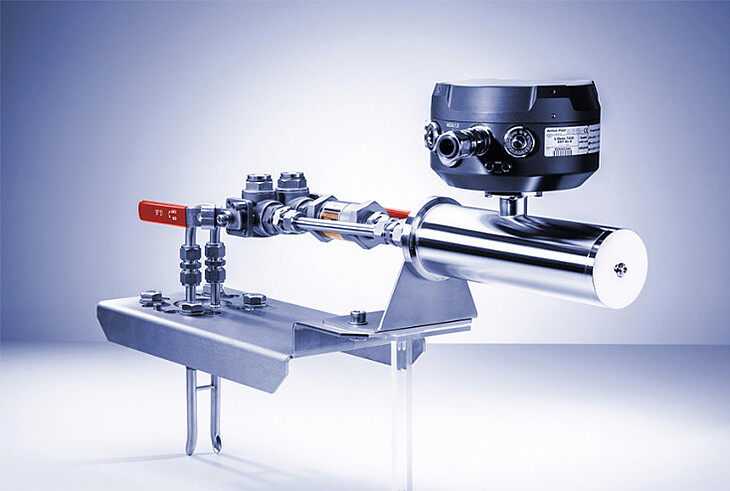
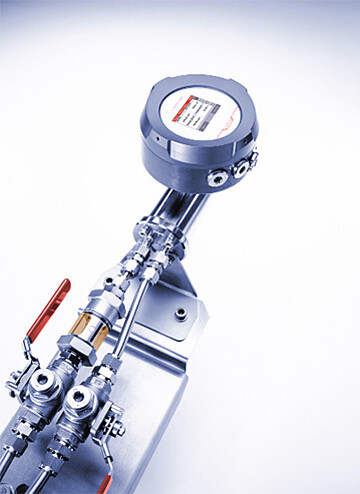
Enabling fast turnaround times at the filling line
When it comes to changing products in the filling lines, time is money. Knowing when the next batch of product is in the line and can be filled into the tank trucks is important information you need to have as soon as possible. To achieve that, Anton Paar's fast but precise SVM viscometer is the best solution. Getting your results in less than four minutes enables you to reduce the amount of lubricant that goes to waste and saves money.
Relevant products:
Unloading lubricants without losses or mix-ups
Preventing mix-ups when unloading will keep your costs and waste low. By measuring the density online during the whole loading process, the operator can check that the correct product is being filled into the correct tank. If the measured density is outside the specified range for the expected product, the pump can be switched off immediately before contamination occurs. Anton Paar’s density sensors are:
- Robust and maintenance-free
- Ready to measure on delivery
- Designed for use in hazardous areas
Minimizing mass balance error at tank farms and fulfilling regulations
Anton Paar devices help you keep tight financial control of custody transfer points and therefore minimize the mass balance error of your tank farm. Combing our online density sensor with a volume flow meter delivers the most accurate mass determination results. You know exactly how much of each product is incoming and outgoing and reap the best financial benefit.
Minimizing product loss and waste when using multiproduct pipelines
To achieve the best product cut in multiproduct lines you need a sensor that detects the product within one second. Anton Paar’s online sensor tells you immediately as soon as the product is outside the defined range so you can close the valve. This sensor will minimize product loss and waste and save you money.
On-site density measurements in hazardous areas (Ex-zone 1)
Working in hazardous areas (Ex-zone 1) you need intrinsically safe instrumentation, e.g. when measuring the density of your petroleum product at the terminal to check whether you will fill the right fuel to your storage tank. Anton Paar’s portable DMA 35 Ex petrol measures specific gravity quickly and directly on-site. Thanks to its ATEX approval it is safe to use directly at the terminal before pumping. The density meter is ASTM D7777 compliant, guarantees user safety, and carries out all relevant unit conversions automatically. It directly takes a small sample volume of only 2 mL from the storage container via its built-in pump.
Relevant products:
Simulating the behavior of final products to understand their stability in storage
Before and after transportation, Anton Paar devices can help you assess the storage behavior of your finished products so you can predict how they behave under certain ambient conditions.
- Discover at which temperatures the product starts to evaporate and forms vapors to ensure the correct classification and storage conditions.
- Check the oxidation stability to avoid problems later such as rust, corrosion, and filter blocking in an engine system.
Relevant products:
Defining the hazard class for transportation and handling
To evaluate the flammability and assign a hazard classification before transportation you need to know the flash point. Anton Paar’s flash point testers implement referee methods used internationally for releasing petroleum products and are also used for the flash point determination of solvents or solvent mixtures. Choose your method:
- Pensky-Martens
- Cleveland
- Tag
- Abel
Relevant products:
Product identification of incoming raw materials
The product identification of incoming raw materials needs to be quick but accurate as there is no room for errors and wasted time when incoming trucks and trains are waiting to be unloaded. SVM 1001 Simple Fill offers semi-automated viscosity determination of incoming goods with lab precision. The optionally battery-powered viscometer is suitable for use in a warehouse or at storage locations, and the quick funnel-filling allows users with a minimum of training and without the use of a pipette or syringe to use the instrument correctly.
Relevant products:
Lubricant testing for consumers
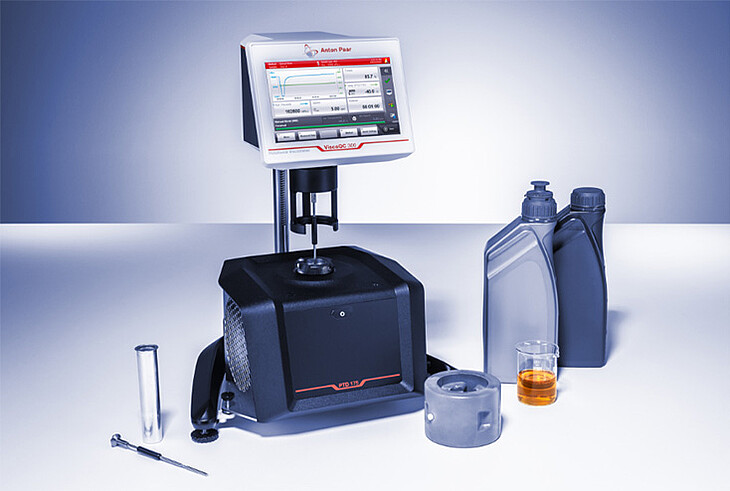
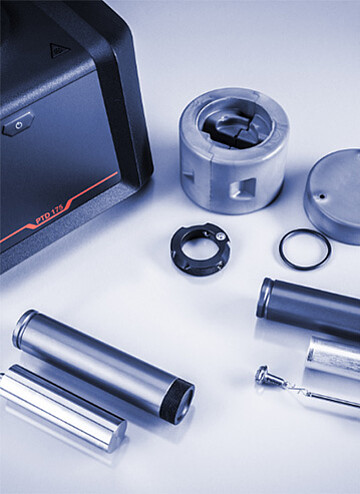
Ensuring reliable operation by oil-condition monitoring (OCM)
Knowing the right time for an oil change not only saves costs but also saves your equipment from damage and avoids unnecessary downtime. One of the key parameters for an oil’s condition are the viscosities at 40 °C and 100 °C. With a viscometer that can perform rapid (and even simultaneous) measurements at these two temperatures and automatically calculate the viscosity index, you can quickly receive all the parameters to know exactly when the time to change your lubricant has arrived.
Automated filling and cleaning of the viscometer means you can increase your productivity, reduce handling errors, and free the operator to perform other important tasks.
Relevant products:
Analyzing the effect of lubrication on wear and friction
By performing a wide variety of tribological tests and simulating friction and wear for your application, the friction coefficient under a specific set of conditions can be determined. This provides insight into the effect of lubrication on friction and wear. Having a rheometer with a highly modular setup which enables the tests to be performed over a large range of deflection angles at different frequencies ensures easy and fast determination of all relevant parameters.
Relevant products:
Observing the viscosity-temperature relationship of (used) engine oil
If the viscosity of the oil is too high or it gels after cold temperature starting, the engine can get damaged. Anton Paar’s rotational viscometers fulfill common standards and test methods to analyze the pumpability and gelation index of engine oils using a temperature-scanning technique. Fully automatic test procedures will save you an enormous amount of time. Just start the measurement and then you can take care of other matters. Benefit from the lowest maintenance work and save space in your lab as you do not need a liquid bath.
Relevant products:
Classification of grease types
The PNR 12 instrument offers a seamless solution that overcomes the challenges associated with manual penetrometers when testing different types of greases. With a user-friendly jog wheel for a precise surface approach and internal storage for test results, it simplifies and streamlines the classification process. Furthermore, users can easily export results through printing, USB storage, or integration with their LIMS system. This comprehensive approach ensures efficient testing procedures while maintaining a secure archive of valuable data, enhancing overall operational effectiveness
Relevant products:
How to ensure proper quality of engine oil at the race track with no need for time consuming lab analysis
Lubricant testing for engines used in the motorsports sector ensures proper performance and durability of all components. With on-site testing of the quality of engine oil, results are obtained with portable density meters that provide insight into significant parameters within seconds. The direct and simple analysis of just a few mL of engine oil provides immediate feedback, allowing assessment of the current quality of the engine oil. The simple sampling via a built-in piston pump leaves no space for errors and does not require further interpretation of the obtained results.
Relevant products:
Classification of grease types for the right choice in bearings
In the context of classifying grease types to make informed decisions on bearing applications, the PNR 12 instrument and Manual Grease Worker offer a comprehensive solution. Customers face a challenge with the premature wear of a vehicle’s moving parts due to incorrect grease type classification. To address this, our solution simplifies the measuring workflow by eliminating human error. Additionally, the manual grease worker ensures consistent wear testing of greases in practical scenarios. Leading bearing manufactures have already benefited from our solution, demonstrating its effectiveness in enhancing the lifetime and performance of vital vehicle components
Relevant products:
Monitoring of in-service oils
Oil condition monitoring is required in the design and manufacturing of engines, transmissions and more. It is crucial to avoid malfunction of machinery and replace the lubricant in time before the performance of the machine is affected.
SVM 1001 offers the ideal solution for the quality control of in-service oils. Fast and reliable viscosity determination can be achieved with unbeatable ease of operation. Depending on the application the instrument can be either combined with a magnetic particle trap to remove ferromagnetic particles to reduce sample preparation needs or be battery-operated for use in mobile labs or directly at the machinery.
Relevant products:
Determining the quality of in-service oils and deciding when to exchange
The quality of in-service oils is important. During use, the quality of oils is negatively affected by impurities. To avoid damage to engines or other lubed parts, determining the quality of the in-service oil is vital for determination of the right time to exchange the oil. Exchanging it too early will increase the running costs, exchanging it too late may lead to severe damage to lubed parts. Monitoring the quality of oil can be performed in a cost cost-saving way via flash-point testing according to ASTM D93. For example, using an impurity matrix and a quality chart will make in-service oil flash point testing as easy as never before.
Relevant products:
Identifying incoming lubes and solvents
Samples being traded require proper identification on arrival. It is crucial to quickly identify the sample's density on-site and on arrival. In most cases, the operation of a portable device is required in an intrinsically safe area. With a portable density meter, these requirements are fulfilled, enabling quick and correct decisions on sample identification right on arrival.
Relevant products:
Streamlined Oil Condition Monitoring (OCM) - 9 Parameters, 1 Measurement for Maximum Efficiency!
In-service lubricant analysis is crucial for industries reliant on machinery performance. Regular analysis aids in detecting contaminants, wear particles, and degradation products present in lubricants. If these issues are discovered early on, maintenance can be scheduled preemptively, reducing the risk of unexpected downtime and minimizing repair costs. Lyza 7000’s innovative capabilities offer an efficient means to conduct these crucial analyses. Incorporating FTIR analysis into maintenance protocols empowers organizations to optimize the timing of oil changes with unparalleled efficiency and cost-effectiveness. By leveraging the rapid analytical capabilities and precise insights provided by FTIR spectroscopy, maintenance professionals can make informed decisions, ensuring optimal equipment performance, reliability, and longevity.
The choice of technology for in-service lubricant analysis is critical. FTIR (Fourier Transform Infrared Spectroscopy) is a highly effective and widely adopted technology for this purpose. Its ability to analyze samples on a molecular level allows for detailed insights into the composition of lubricants. FTIR enables the precise identification and analysis of a wide range of contaminants, oxidative degradation, and additive depletion within lubricating oil samples. Lyza 7000 harnesses the power of FTIR in a streamlined, all-in-one package, making it an indispensable tool for precise and comprehensive oil condition monitoring.
Relevant products:
Lubricant testing at testing laboratories
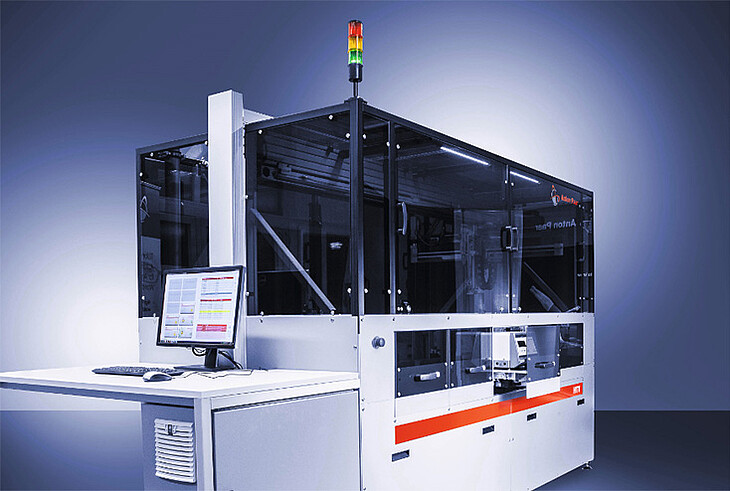
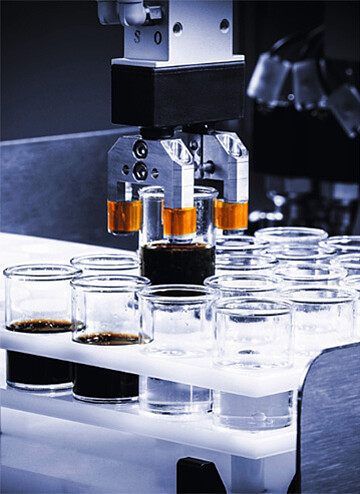
Automating on a large scale for oil-condition monitoring and the highest throughput
As the ultimate answer to the need for high sample throughput and minimized human interaction, Anton Paar’s automation platform takes care of sample preparation and analytics customized to your requirements, e.g.:
- 6 viscometers with storage units
- Combinations with Anton Paar instruments possible (e.g. density meter, rheometer and robotic arm)
- Integration of third-party devices, including heating ovens, analyzers with flow cells, balances, and more
The automation solution runs the analysis while your lab personnel work on other tasks. Anton Paar’s engineering team customizes the setup to suit your routines.
Ensuring higher productivity and efficient data flow in the lab
In contract laboratories and testing labs, minimizing the time and cost per sample can be achieved by:
- Increasing sample throughput by automating the filling and cleaning process, e.g. by adding a sample changer or heated sample changer to your density meters and viscometers
- Reducing solvent consumption by automating filling, even for single samples
- Employing software for lab execution for seamless data flow to your LIMS and ultimate traceability of results in your paperless lab
Relevant products:
Automating sample preparation for more efficient lab processes
Freeing up your lab personnel from repetitive work will increase your sample throughput and reduce the potential for human error. Anton Paar’s automated solution covers sample identification, vial capping, sub-sampling, mixing, and dosing. The system also works at night and on weekends, preparing your samples for downstream analytics in the fastest way possible.
Our engineering team analyzes your workflow and custom-tailors the right setup, including:
- Bi-directional communication with your LIMS
- The combination of work steps you need
Simple analysis of highly viscous samples
Filling your density meter or viscometer properly can be challenging when it comes to heavy samples, as they require heating. Anton Paar offers heated sample changers that minimize the operator’s contact with hot substances and contribute to your lab’s safety and productivity. Even if tempering is not necessary for compliance, heating samples makes filling quicker and easier and increases your throughput per day.
Relevant products:
Fast viscosity index determination
The viscosity index is a crucial parameter for the specification of lubricants. Thus, determination needs to be fast but precise with a minimum of sample required. SVM 4001 is the dedicated instrument for the lubricant industry within Anton Paar’s viscometer portfolio and a perfect solution for viscosity measurement at two temperatures and for VI calculation. The innovative dual viscosity/density cell enables simultaneous measurements at two individual temperatures for fast viscosity index determination in full compliance with ASTM D2270, using the lowest sample volume on the market – just 2.5 mL.
Relevant products:
Digitization and harmonization of laboratory instrument data
AP Connect is your digital hub for automated data transfer from your instruments to a central database.
With AP Connect, you can:
- Easily transfer data from your instruments to a central database, regardless of the manufacturer.
- Export measurement results to a specified location or access them directly with a standardized API.
- Drive digitalization forward and meet your requirements for streamlined data handling.
- Use AP Connect in many different applications and industries.
- Meet current regulations and requirements in the regulated environment with the Pharma Edition.
The benefits of using AP Connect:
- Increased efficiency: AP Connect automates the data transfer process, freeing up your time so you can focus on other tasks.
- Improved accuracy: AP Connect ensures that data is transferred accurately and securely, reducing the risk of errors.
- Enhanced compliance: AP Connect helps you meet regulatory requirements for data management.
- Improved decision-making: AP Connect provides you with easy access to data, so you can make informed decisions about your experiments.
If you are looking for a digital hub to help you automate data transfer, improve efficiency, and meet regulatory requirements, then AP Connect is the solution for you.
Relevant products:
High-throughput oil testing and analysis
Analyze a high amount of used oils and handle the whole workflow (e.g., sample preparation, measurement) in a fully automated way: fully automated measurements for transparent and opaque liquids, including new and used formulated oils, gear lubricants, engine oils, hydraulic fluids, and fuels. With the HTV or HTX solution, huge analysis laboratories for oil testing have a perfect solution for unattended, 24/7 runs. Measurements up to 1,600 samples a day can be covered and all workflows regarding sample preparation and cleaning of the instruments run entirely on their own.
Density analysis for lubricants and oil formulations
The function of a lubricant is to protect and guard against metal-to-metal contact caused by friction while cooling and cleaning the metal surfaces. Lubricants are generally less dense than water and typically will float. However, lubricants can be modified with additives and thickening agents to increase the density if necessary. Lubricant modification can affect the load-carrying and sealing capacity of the lubricating films. There are many methods to determine the density of lubricant. The most commonly used method is with a hydrometer that follows ASTM D1298. This method requires an external water bath for consistent temperature and the use of large sample amounts for measurements. Another method that can be used to determine the density of lubricants is with a digital density meter with an oscillating u-tube. This is an optimal solution for many customers who produce lower-viscosity lubricants that are easily syringed in and out. The efficiency of this method changes when the density of high-viscosity lubricants needs to be measured. High-viscosity fluids in general and high-viscosity lubricants in particular present an issue related to loading the sample into the syringe and eventually inside the u-tube. This is not a problem for the Ultrapyc 5000 gas pycnometer. The instrument, with its groundbreaking innovation in density analysis, offers a wide-mouth sample cell and disposable cups that make transferring or loading a sample easy. Customers who have successfully adopted new gas pycnometry and purchased the Ultrapyc 5000 report faster measurement times, higher accuracy, and an increase in productivity and overall satisfaction. The principle behind measuring density is the gas displacement method. Sample settlement or sample phase separation is never an issue for the Ultrapyc 5000 gas pycnometer. Features like PowderProtect mode or bi-directionality (the only gas pycnometer on the market), TruPyc technology, and the touchscreen interface provide an ideal solution for density measurements of lubricants of various viscosities.
Relevant products:
High-throughput shear viscosity analysis of used greases
Perform fully automated, 24/7 rheological measurements with no downtime and maximum productivity with the HTR 3000. Analyze the shear viscosity of used greases to know if oils are still suitable for use.
Relevant products:
Swift Oil Condition Monitoring (OCM): 9 Parameters for Compliance with ASTM Standards for Rapid Oil Condition Monitoring!
Lubrication oil plays a crucial role in the smooth functioning and longevity of machinery in various industries. Over time, the quality of lubrication oil can degrade due to factors such as contamination, oxidation, and wear particles. Traditional methods of oil analysis have limitations in providing real-time, comprehensive insights into the oil’s condition. However, Fourier Transform Infrared (FTIR) spectroscopy has emerged as a powerful and versatile tool for monitoring the condition of lubrication oil.
Setting itself apart from traditional FTIR spectrometers, Lyza 7000 allows the conducting of multiple ASTM-compliant measurements and customized methods with a single button, simplifying complex spectroscopic analysis in one cohesive workflow.
Relevant products:







